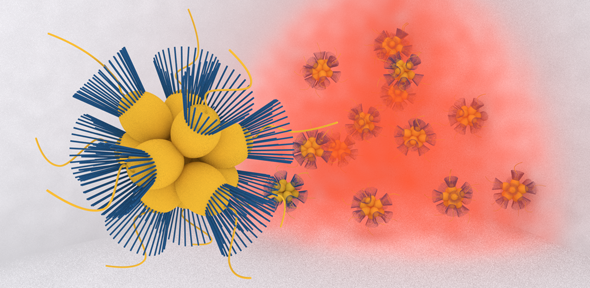How single-celled organisms navigate to oxygen

A team of researchers has discovered that tiny clusters of single-celled organisms that inhabit the world's oceans and lakes, are capable of navigating their way to oxygen. Writing in e-Life scientists at the University of Cambridge describe how choanaflagellates, the closest relatives of animals, form small colonies that can sense a large range of concentrations of oxygen in the water. The research offers clues as to how these organisms evolved into multi-cellular ones.
Although the single-celled ancestors of animals are extinct, the choanoflagellates, which evolved from a common ancestor and which have remained single-celled since the Cambrian period around 500 million years ago, are common in the Earth's oceans and lakes. Certain choanoflagellate species form small swimming colonies and these colonies are thought to resemble the early multicellular organisms that later evolved into animals. Oxygen levels on the planet started rising in the pre-Cambrian period and it's likely this played a major influence on the emergence of these multicellular life forms.
The researchers observed choanoflagellate colonies swimming under controlled conditions and varied the oxygen concentration in the water over time. They found the colonies navigate based on the logarithm of the oxygen concentration, similar to the way humans sense sound and light. This increases their sensing capabilities in low-oxygen environments where navigation becomes crucial for survival.
One of the authors on the paper, Professor Raymond E. Goldstein, of the University's Department of Applied Mathematics and Theoretical Physics, says:
"Our work provides the first evidence that choanoflagellates can sense, and move towards, oxygen. Since choanoflagellates are now understood to be the closest relatives of animals, this discovery may shed light on the properties of the last common ancestor of the two groups, and in particular its response to the changing oxygen levels in the Precambrian era. Perhaps more importantly, the work raises fascinating questions about how the simplest multicellular organisms, lacking any type of central nervous system, sense and respond to their environment."
Many organisms find their way to favourable areas by using different strategies. Bacteria bias their tumbling to navigate towards food and algae can turn and move directly towards light. While choanaflagellates require oxygen, it wasn't known if they could successfully navigate towards it. But the research showed both single cells and swimming colonies were able to find it.
While animals require enormous amounts of coordination between their cells in order to navigate, this research reveals such coordination isn't needed for simple multicellular life forms. In addition, microorganisms' search for food is rendered more difficult by the presence of thermal noise. Being so small, microorganisms are constantly being buffeted by vibrations in the waters that surround them, and their search strategy needs to be robust to counter this.
More information: Julius B Kirkegaard et al. Aerotaxis in the closest relatives of animals, eLife (2016). DOI: 10.7554/eLife.18109
Journal information: eLife
Provided by University of Cambridge





















